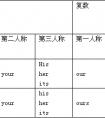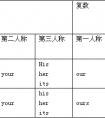用所给单词的适当形式填空。1.Let_____(they)watchTVnow.2.Howmanyphotos_____Lily_____(have)?3.Please _____ (listen)theteachercarefully. 4.Marylikes _____(wri-七年级英语
④That is an eraser. 那是一块橡皮擦。
五、不可数名词作主语时为第三人称单数。如:
①The milk is in the glass. 牛奶在玻璃杯里。
②The bread is very small. 那面包很小。
六、当数字或字母作主语时,看作第三人称单数。如:
①"6" is a lucky number. "6"是个吉利数字。
②"I" is a letter. "I"是个字母。
考点名称:实义动词的单数第三人称形式
在一般现在时的肯定句中,当主语为非第三人称单数时,谓语动词用原形;
当主语为第三人称单数时,谓语动词用单数第三人称形式。- 实义动词的一般现在时的单数第三人称形式遵从“s,es, ies”六字母规则。如下表所示:
实意动词单数第三人称变化规律:规则 动词原形 第三人称
单数形式s 一般在词尾加s(读音规则:
清清浊浊元浊,
在清辅音后读清辅音/s/,
在浊辅音和元音后读/z/)stop
take
clean
play
growstops/s/
takes/s/
cleans/z/
plays/z/
grows/z/es 以,x,ch,sh,或o结尾的动词
加-es(读/iz/)pass
fix
wash
watch
dopasses
fixes
washes
watches
doesies 以辅音字母
加y结尾的动词,变y为ies(读/iz/)fly
carry
hurryflies
carries
hurries
注意:不规则变化的有have—has, be—is, go—goes, do—does 一般现在时,当主语是第三人称单数时,谓语动词要用第三人称单数形式
主语是第三人称单数有以下几种情况:(1) 不可数名词做主语:
Some water is in the glass(2) 单个的可数名词做主语:
The girl is Chinese. My watch is on the dresser.
(3) He ,she , it 等代词单个做主语:
He is in the tree. She likes her family very much.
(4) 单个的人名,地名或称呼作主语:
Mary is a doctor. Uncle Li speaks a little English.
Changchun is a beautiful city.(5) 指示代词this, that 等作主语:
This is a pear. That is an apple .(6) Everyone, everything ,something, nobody, nothing.等不定代词作主语时
Is everyone here today? Everything is ok .(7)单个数字作主语时:
”8” is a good number in China.
动词单数第三人称形式的一般现在时的句子的否定句、疑问句及特殊疑问句。 <?xml:namespace prefix = "o" ns = "urn:schemas-microsoft-com:office:office" />否定句:
在主语的后面实义动词前加doesn’t(注意实义动词应恢复原形。)主语(单三)+doesn’ + 动词原形+其他
Jim likes football变否定: Jim doesn’t like football
He has lunch at school. 变否定:He doesn’t have lunch at school.
一般疑问句及答语,在句子前面加助动词does. 实义动词恢复原形Does +主语(单三)+ 动词原形+其他
Does your father work ? Yes, he does. /No, he doesn’t
特殊疑问句:特殊疑问词+一般疑问句特殊疑问词+ does +主语(单三)+ 动词原形+其他
Where does a bird live ?
How does she go to school?
考点名称:助动词的单数第三人称形式
- 助动词的单三形式:
助动词
be
do
have
shall
will
单三形式
is
does
has
shall
will
考点名称:动名词
- 动名词:
如果一个动词加上了ing变成了名词,那么这个词称动名词。 动名词是一种兼有动词和名词特征的非限定动词。
它可以支配宾语,也能被副词修饰。
由于动名词是由动词变化而来,它仍保留着动词的某些特征,具有动词的某些变化形式,用以表达名词所不能表达的较为复杂的意念。
动名词的名词特征表现在它可在句子中当名词来用,作主语、宾语、表语、定语。 动名词的结构和形式:
动名词的否定结构:
动名词的否定结构由not 动名词组成。如:
Trying without success is better than not trying at all. 实验没有成功也比不实验好。
He hated himself for not having work hard. 他悔恨自己没有用功。
I’m sorry for not having telephoned you before. 很抱歉,没有早给你打电话。
He felt sorry for not having done the work well. 他为没有把工作做好感到难过。
- 最新内容
- 相关内容
- 网友推荐
- 图文推荐
| [家长教育] 孩子为什么会和父母感情疏离? (2019-07-14) |
| [教师分享] 给远方姐姐的一封信 (2018-11-07) |
| [教师分享] 伸缩门 (2018-11-07) |
| [教师分享] 回家乡 (2018-11-07) |
| [教师分享] 是风味也是人间 (2018-11-07) |
| [教师分享] 一句格言的启示 (2018-11-07) |
| [教师分享] 无规矩不成方圆 (2018-11-07) |
| [教师分享] 第十届全国教育名家论坛有感(二) (2018-11-07) |
| [教师分享] 贪玩的小狗 (2018-11-07) |
| [教师分享] 未命名文章 (2018-11-07) |

![Can you tellyour name?[ ]A. I B. meC. my D. mine-七年级英语](http://www.00-edu.com/d/file/ks/4/2/renchengdaici/2019-11-29/smallaa364e43e5a60c14a303f4c0130566e11575032405.png)


![_____ a cat. _____ name's Mimi. [ ]A. It's, It's B. Its, It's C. It's, ItsD. Its, Its -七年级英语](http://www.00-edu.com/d/file/ks/4/2/renchengdaici/2019-11-29/small3d77ed9f3a276fbdbe50d7d083528cb11575029994.jpg)
![Pu Cunxin is a good film star (电影明星). _____ is tall and he _____small eyes.[ ]A. His; hasB. He; hasC. He; isD. His; is-七年级英语](http://www.00-edu.com/d/file/ks/4/2/renchengdaici/2019-11-29/small1be6e01031d0d1da1dc8d9521925f3de1575032118.png)
